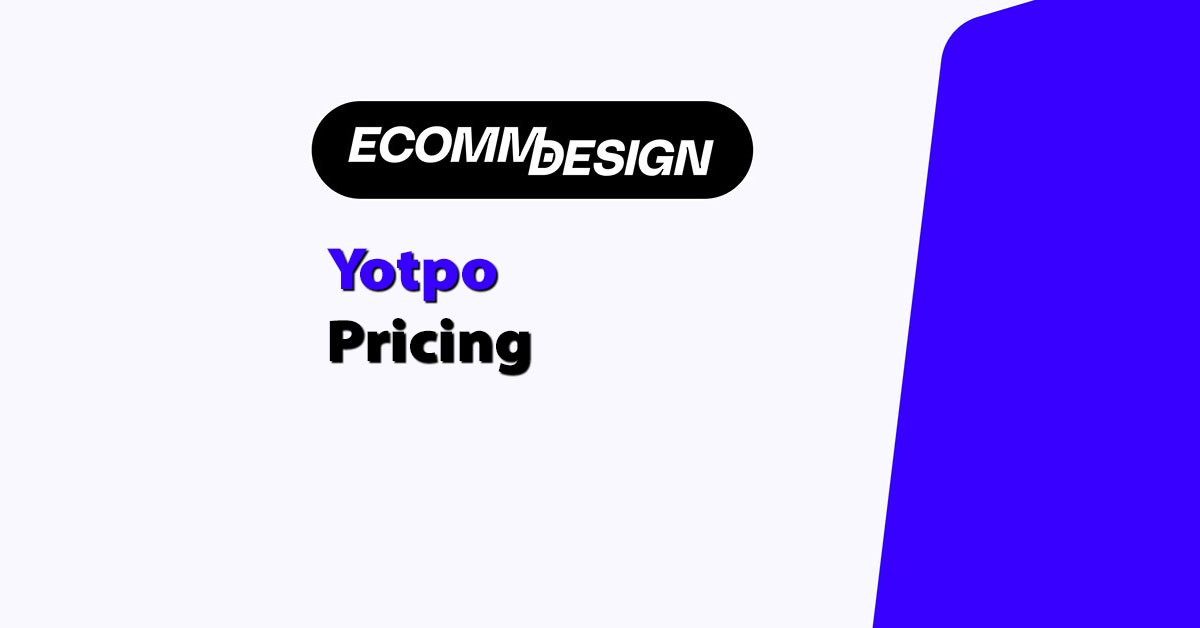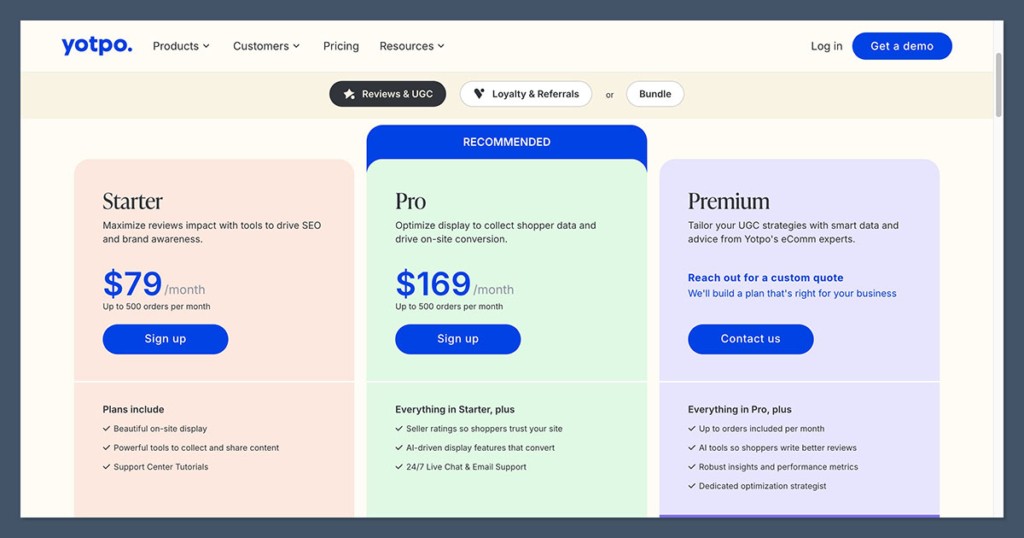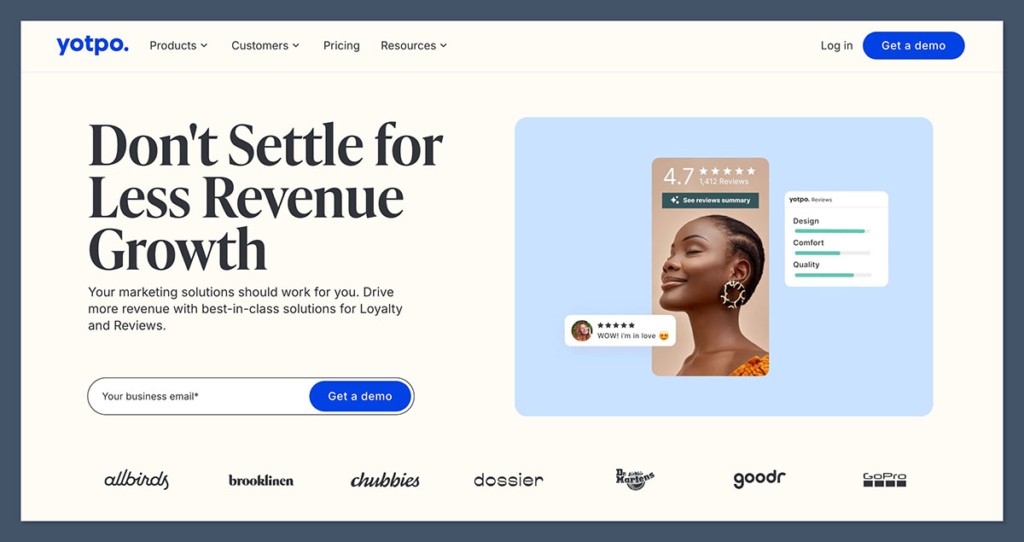
Yotpo is one of the most well-known eCommerce marketing platforms, offering features such as product reviews, loyalty programs, SMS marketing, and subscriptions.
I’ve researched Yotpo’s plans, talked to merchants using the platform, and compared it with other review and loyalty tools — so I can tell you exactly what you can expect to pay, what you get for that money, and whether it’s worth it for your business.
Why You Can Trust This Review
I’ve spent over 30 hours researching Yotpo’s pricing structure, testing its features across Shopify and BigCommerce stores, and reviewing public merchant feedback from platforms like G2, Capterra, and Trustpilot.
This review is based on both official pricing data and real-world usage examples from eCommerce brands of different sizes.
Yotpo at a Glance
Best for: eCommerce brands looking for all-in-one marketing tools (reviews, loyalty, SMS)
Overall rating: 4.4 out of 5
Pricing range: Free – $3,000+/month depending on plan, modules, and usage
Pros
✔️ Combines reviews, loyalty, and SMS marketing in one platform
✔️ Scales for both small and enterprise-level stores
✔️ Excellent Shopify and BigCommerce integrations
✔️ Review syndication to Google Shopping
Cons
❌ Pricing scales quickly with order volume
❌ Each module is billed separately
❌ Design customization can be limited on lower plans
❌ No flat-rate option for unlimited usage
Quick Summary: Yotpo’s Best and Worst Features
What I Like
- Modular flexibility — you only pay for the features you choose (reviews, loyalty, SMS, subscriptions).
- Great for scaling — works for both a 50-order/month boutique store and a 10,000-order/month enterprise.
- Solid integrations — especially with Shopify, BigCommerce, WooCommerce, and Klaviyo.
- Real ROI potential — loyalty programs can boost repeat purchases by up to 30%.
What I Dislike
- Opaque enterprise pricing — you’ll need to contact sales for higher-tier quotes.
- Price creep — order growth quickly pushes you into higher-cost tiers.
- Separate billing — running Reviews + Loyalty + SMS means paying three invoices.
- Free plan branding — you can’t remove Yotpo’s logo unless you upgrade.
My Experience With Yotpo Pricing

When I first tested Yotpo on a Shopify store, I started with the Free plan to get a feel for the review request flows and widget integration.
Setup was straightforward — I could connect my store, import past orders, and start sending review requests within an hour.
The problem came when I wanted to:
- Remove Yotpo branding
- Add photo and video reviews
- Integrate with my Klaviyo email flows
Those three changes bumped me into the Growth plan, which started at $15/month for reviews.
That seemed reasonable — until I realized loyalty was a separate $29/month, and SMS had its own $19/month base fee plus per-message charges.
Yotpo Pricing Plans
Here’s an overview of typical US pricing based on order volume and product selection:
| Plan | Price (USD) | Order Limit | Key Features |
|---|---|---|---|
| Free | $0 | Up to 50 orders/mo | Basic reviews, Yotpo branding |
| Growth (Reviews) | $15–$79 | 50–1,000 orders | Photo reviews, basic integrations, limited customization |
| Growth (Loyalty) | $29–$79 | Usage-based | Points & rewards, referrals |
| SMS Marketing | $19/mo + $0.015–$0.05 per SMS | Unlimited contacts | SMS broadcasts, automations |
| Premium | $79–$149/module | 200–1,000+ orders | Advanced customization, analytics, no branding |
| Enterprise | $500–$3,000+ | Custom | All features, API, dedicated account manager |
Note: Each module is billed separately — so a store using Reviews, Loyalty, and SMS will combine three plan prices.
One thing to be aware of is that Yotpo sometimes offers custom bundles or promotional pricing if you commit to multiple products for a year or more.
This can make a big difference, especially if you’re scaling quickly and anticipate needing both Reviews and Loyalty in the near future.
It’s also worth noting that some merchants have reported negotiating add-on features at no extra cost during contract renewals, which is a tactic you can use to stretch your budget further.
Is Yotpo Good Value for Money?

If you’re only using Reviews or Loyalty on a smaller store, Yotpo’s Growth plan is competitive.
But once you start combining modules and scaling order volume, the monthly cost can rival or exceed other tools.
Example:
A Shopify store doing 800 orders/month with Reviews Premium ($149), Loyalty Premium ($149), SMS base fee ($19) + $30 in usage pays ~$347/month.
For an established brand, that’s still cost-effective if it drives customer lifetime value. For a new store, it might be overkill.
That said, value isn’t just about the monthly subscription cost — it’s about the revenue impact.
If Yotpo helps you generate more reviews that improve conversion rates, or a loyalty program that increases repeat orders, the return can outweigh the expense.
The challenge for smaller brands is hitting the usage levels needed to fully justify the spend before the price scales up.
Yotpo Free Plan: Who It Works For
The free plan is ideal if you:
- Have fewer than 50 orders/month
- Want a basic review widget with minimal setup
- Don’t mind Yotpo branding
- Are testing if reviews increase conversions
If you need brand control, visual reviews, or loyalty rewards, you’ll need a paid plan.
For very small or brand-new stores, the free plan can actually be a smart marketing tool. You can collect early reviews without committing to a long-term contract, giving you proof of customer satisfaction to help with conversion rates.
When the time comes to scale, you’ll already have a library of user-generated content that can make upgrading to a paid plan far more effective from day one.
Premium & Enterprise Plans
These tiers unlock:
- No branding
- API access
- Multi-language support
- Advanced analytics
- Dedicated account management
I’ve seen large brands negotiate annual enterprise contracts for $1,200–$2,500/month covering Reviews, Loyalty, and SMS.
At this level, Yotpo is less about “justifying the cost” and more about maximizing the integration of all customer touchpoints.
Premium and Enterprise plans give you the flexibility to align the platform with your CRM, personalisation engine, and analytics stack — making it a central hub for retention marketing.
For global brands, the multi-language support and API capabilities can also be a big driver for choosing Yotpo over smaller competitors.
How Yotpo Compares to Alternatives
| Platform | Starting Price | Strengths | Weaknesses |
|---|---|---|---|
| Yotpo | Free – $3,000+ | All-in-one, enterprise scalability | Price scales quickly |
| Stamped.io | $23/mo | Affordable, strong reviews/loyalty | Limited SMS features |
| Loox | $9.99/mo | Excellent photo reviews | No loyalty or SMS |
| Judge.me | $15/mo flat | Unlimited orders, low cost | Less advanced UI |
| Trustpilot | $250+/mo | Strong brand trust | Less product review focus |
If you need one dashboard for reviews, loyalty, and SMS, Yotpo is unmatched. If you’re cost-sensitive, Stamped.io or Judge.me are better.
While Stamped.io and Loox can be strong alternatives for specific use cases, neither offers the same breadth of modules that Yotpo does.
This means that while you might save on subscription costs by mixing different tools, you’ll need to manage multiple logins, integrations, and possibly overlapping data — which can lead to inefficiencies over time.
For some brands, the simplicity of an all-in-one platform is worth the premium.
Tips for Saving Money on Yotpo
- Bundle features — negotiate discounts when adding multiple modules.
- Annual contracts — save 10–20% with upfront payment.
- Optimize SMS — clean inactive numbers to lower per-message fees.
- Monitor order volume — request grace periods for seasonal spikes.
Another tactic is to start with only the modules you need most urgently and then phase in others later.
For example, a brand might begin with Reviews to improve conversion rates, and only add Loyalty once they have enough repeat customers to make it worthwhile.
By staggering adoption, you can delay higher costs while still building towards a fully integrated Yotpo setup.
Real-World Merchant Examples
- Fashion brand (Shopify Plus) — 10,000+ orders/mo, $1,200/mo for Reviews + Loyalty + SMS, saw 28% boost in repeat purchases.
- Coffee brand (Shopify) — 300 orders/mo, $49 Reviews Growth + $15 SMS, loyalty dropped due to cost.
- Electronics retailer (BigCommerce) — 2,000 orders/mo, $2,000/mo Enterprise, 40% increase in customer lifetime value.
In all three cases, the merchants reported that Yotpo’s performance aligned closely with their specific goals.
The fashion brand prioritized retention, the coffee brand focused on early customer feedback, and the electronics retailer needed enterprise-level integration.
This highlights that the “right” Yotpo plan is highly dependent on your store’s growth stage and strategic priorities — there’s no one-size-fits-all choice.
Verdict: Should You Choose Yotpo?
Yotpo is best for established eCommerce businesses that:
- Want all-in-one marketing features under one login
- Have budget to invest in scalable tools
- Value deep Shopify or BigCommerce integration
If you’re a small or early-stage store, you might find better short-term value with cheaper review tools — and then upgrade to Yotpo once you need its advanced capabilities.
Ultimately, Yotpo’s pricing makes the most sense if you can commit to using its features to their full potential.
If you only plan to use one module lightly, a more focused tool will likely deliver a better return.
But for brands ready to invest in retention and long-term customer engagement, Yotpo remains one of the most powerful — and flexible — platforms on the market.






